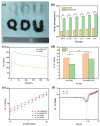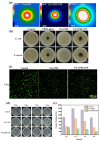Carbonized Plant Powder Gel for Rapid Hemostasis and Sterilization in Regard to Irregular Wounds
- PMID: 39728528
- PMCID: PMC11728490
- DOI: 10.3390/nano14241992
Carbonized Plant Powder Gel for Rapid Hemostasis and Sterilization in Regard to Irregular Wounds
Abstract
Irregularly shaped wounds cause severe chronic infections, which have attracted worldwide attention due to their high prevalence and poor treatment outcomes. In this study, we designed a new composite functional dressing consisting of traditional Chinese herb carbonized plant powder (CPP) and a polyacrylic acid (PAA)/polyethylenimine (PEI) gel. The rapid gelation of the dressing within 6-8 s allowed the gel to be firmly attached to an irregularly shaped wound surface and avoided powder detachment. In addition, through an infrared thermography analysis, a coagulation assay, and a morphological examination of regenerative tissue in animal wound models, it was found that the dressing substrates had synergistic effects on photothermal sterilization, rapid hemostasis, and anti-inflammatory activity, thereby achieving an 88% wound closure rate on the 9th day after the formation of the wound. This multifunctional hemostatic material is expected to be adaptable to irregular wounds and promote rapid wound healing.
Keywords: carbonized plant powder; gel; irregular wounds; photothermal stabilization; rapid hemostasis.
Conflict of interest statement
The authors declare no conflicts of interest.
Figures





Similar articles
-
A self-gelling powder based on polyacrylic acid/polyacrylamide/quaternate chitosan for rapid hemostasis.Int J Biol Macromol. 2023 Mar 31;232:123449. doi: 10.1016/j.ijbiomac.2023.123449. Epub 2023 Jan 26. Int J Biol Macromol. 2023. PMID: 36709811
-
Robust and Wet Adhesive Self-Gelling Powders for Rapid Hemostasis and Efficient Wound Healing.ACS Appl Mater Interfaces. 2024 Feb 14;16(6):6756-6771. doi: 10.1021/acsami.3c14944. Epub 2024 Jan 30. ACS Appl Mater Interfaces. 2024. PMID: 38291577
-
Bioinspired multifunctional injectable hydrogel for hemostasis and infected wound management.Acta Biomater. 2023 Apr 15;161:50-66. doi: 10.1016/j.actbio.2023.01.021. Epub 2023 Jan 12. Acta Biomater. 2023. PMID: 36640951
-
Comparative analysis of the hemostatic, analgesic and healing effects of cyanoacrylate on free gingival graft surgical wounds in donor and recipient areas: a systematic review.J Mater Sci Mater Med. 2021 Aug 18;32(9):98. doi: 10.1007/s10856-021-06573-z. J Mater Sci Mater Med. 2021. PMID: 34406492 Free PMC article.
-
Multifunctional Nanoclay-Based Hemostatic Materials for Wound Healing: A Review.Adv Healthc Mater. 2024 Mar;13(6):e2302700. doi: 10.1002/adhm.202302700. Epub 2023 Nov 2. Adv Healthc Mater. 2024. PMID: 37816310 Review.
References
-
- Han S.J., Wan Q.Z., Zhou K.C., Yan A., Lin Z.B., Shu B., Liu C. Sensitive, Stretchable, and Breathable Pressure Sensors Based on Medical Gauze Integrated with Silver Nanowires and Elastomers. ACS Appl. Nano Mater. 2021;4:8273–8281. doi: 10.1021/acsanm.1c01455. - DOI
-
- Lang S.Y., Chen C.J., Xiang J., Liu Y.Q., Li K.J., Hu S., Liu G.Y. Facile and Robust Antibacterial Functionalization of Medical Cotton Gauze with Gallic Acids to Accelerate Wound Healing. Ind. Eng. Chem. Res. 2021;60:10225–10234. doi: 10.1021/acs.iecr.1c01833. - DOI
Grants and funding
LinkOut - more resources
Full Text Sources

